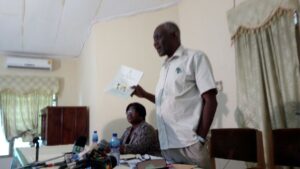
Post Source: Blogspot
Increased crop yield and increased farmer income have been highlighted as two of the most important successes of the mass production of genetically modified (GM) crops since they were first commercialised 20 years ago.
Prof. Walter Alhassan launches 2015 GM crop report.
Speaking on Thursday, May 26, 2016 in Bunso, near Koforidua in the Eastern Region, Professor Walter Sandow Alhassan, an agricultural consultant, referred to documentation on GM crops to tout the impact of this class of crops, saying: they have “increased farmer profits by 68%.”

Prof. Walter Alhassan launches 2015 GM crop report
He indicated that trend analysis showed an increased adoption of GM crops by developing countries – evidence that farmers were being successful in the cultivation of the crops on the one hand and a slap in the face for anti-GM groups on the other.
About 60 people were in attendance when Professor Sandow Alhassan, a former Director General of the CSIR, launched the 2015 Global Status of Biotech/GM Crops report of the International Service for the Acquisition of Agri-biotech Applications (ISAAA) at the Bunso-based Plant Genetic Resources Research Institute (PGRRI) of the Council for Scientific and Industrial Research (CSIR). The occasion also allowed journalists to interact with scientists at the PGRRI under the collective auspices of the ISAAA Ghana Office, African Agricultural Technology Foundation (AATF), the CSIR, Ghana Chapter of the Open Forum in Agricultural Biotechnology in Africa (OFAB Ghana) and the Media Platform on Environment and Climate Change (MPEC Ghana).
GM explained
GM crops, also called biotech crops, are formed from the movement of genes artificially from one organism to another to form a new product with desired characteristics. The species may or may not be related.
According to Dr. Lawrence Misa Aboagye, Director of CSIR-PGRRI, “GM Crops are developed through the combination of genes to obtain new desired products – for example, early maturity crops to match the reduced rainfall, heat and drought tolerant varieties and high yielding varieties.”
From 1.7m to almost 180m hectares
Professor Sandow Alhassan, referencing the ISAAA’s Brief 51, which was authored by Clive James and others, celebrated the steady rise in the land mass cultivated by GM crop farmers. He said during the 20-year period of 1996-2016, the land mass for GM crops recorded “more than 100-fold from 1.7 to 179.7 million hectares.”
He emphasized that this rise made GM the “fastest adopted crop technology” and reflects “farmer satisfaction with biotech crops.”
In the Executive Summary to the ISAAA Brief 51, Dr. Clive James, Founder and Emeritus Chair of the ISAAA, writes that “The meta-analysis conducted by Klumper and Qaim (2014) on 147 published biotech crop studies during the last 20 years, concluded that ‘on average, GM technology adoption has reduced chemical pesticide use by 37%, increased crop yields by 22%, and increased farmer profits by 68%. Yield gains and pesticide reductions are larger for insect-resistant crops than for herbicide-tolerant crops. Yield and profit gains are higher in developing countries than in developed countries’.”

Poor small-holder farmers and developing countries
Dr. James further writes that “In the period 1996 to 2015, up to approximately 18 million farmers, grew biotech crops annually – remarkably, about 90%, or 16.5 million, were risk-averse small, poor farmers in developing countries.
“The latest economic data available for the period 1996 to 2014 indicates that farmers in China gained US$17.5 billion and in India US$18.3 billion. In addition to economic gains, farmers benefited enormously from at least a 50% reduction in the number of insecticide applications, thereby reducing farmer exposure to insecticides, and importantly contributed to a more sustainable environment and better quality of life.”
The ISAAA is also excited that for the fourth consecutive year, developing countries planted more biotech crops than industrial countries, beating industrial countries by 14.5 million hectares. Its brief expatiates that in 2015, Latin American, Asian and African farmers collectively grew 97.1 million hectares or 54% of the global 179.7 million biotech hectares (versus 53% in 2014) compared with industrial countries at 82.6 million hectares or 46% (versus 47% in 2014).
However, there were challenges for Africa, Dr. James acknowledged. “A devastating drought in South Africa resulted in the country decreasing its intended biotech crop hectarage in 2015 by approximately 700,000 hectares from 3 million hectares to 2.3 million hectares – a massive 23% decrease. This underscores yet again the critical nature, and potentially life-threatening importance of drought in Africa and the impending new drought challenges exacerbated by climate change,” he noted.
Meanwhile, Sudan increased biotech cotton hectarage by 30% to 120,000 hectares whilst political transition changes and fiber quality precluded a potentially higher hectarage than a mere 400,000 hectares in Burkina Faso.
Dr. James appears encouraged that an additional eight countries (Cameroon, Egypt, Ghana, Kenya, Malawi, Nigeria, Swaziland and Uganda) conducted field trials on priority African crops, the penultimate step prior to approval. The on-going trials focus on traits of high relevance to challenges facing Africa, including drought, nitrogen use efficiency, salt tolerance, nutritional enhancement, as well as resistance to tropical pests and diseases.
Ghana trying 3 crops
Ghana’s response has been the trial of three crops. According to Prof. Alhassan, the trials are being supported in various ways by Monsanto, AATF, the United States Agency for International Development (USAID), and Arcadia Biosciences.
Supplying more information, Dr. Misa Aboagye stated that “Ghana can boast of a record 140 crop varieties that have been bred and released to farmers. Currently in Ghana, confined trials are being conducted on three GM crops, namely: cotton, cowpea and rice in some CSIR institutes.”
He assured that: “It should be noted that, these trials are supervised by the National Biosafety Authority (NBA), a regulatory body which receives and processes applications for confined field trials of GM crops.”
Credits:
Credit to Emelia Ennin Abbey for Prof. Alhassan’s photo; Dr. Clive James for the chart; and the Business and Financial Times for publishing this story on Page 32 of the Monday May 30, 2016 edition.
POST BY: Frederick Asiamah

Leave A Comment